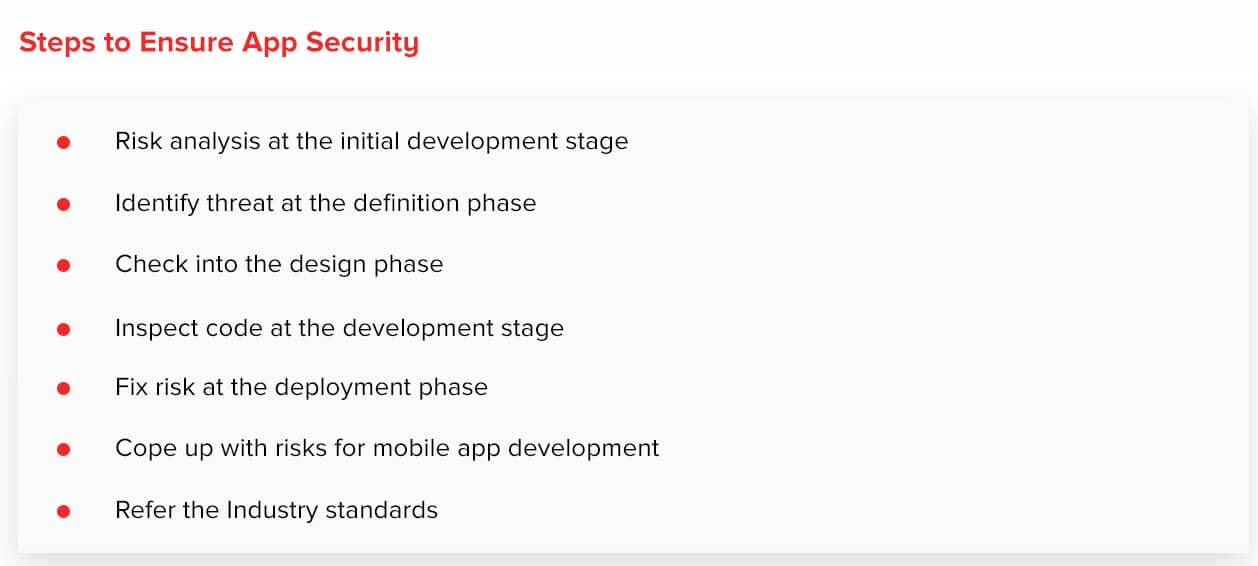Originally published May 29, 2017, updated September 06, 2018
Mobile devices have surpassed PCs and laptops and have become the best medium to access content and services. Businesses are already into mobile application development to attract new customers and increase the employee productivity. But this fast paced app development has introduced a major mobile app security concern for businesses.
Secure mobile application development is one of the most demanded services these days. After seeing too many threats on their apps which has resulted in reduction of traffic, businesses have shifted their focus on the development of a mobile app with the security aspect incorporated into it.
Recent cyber attacks have awakened the businesses to rethink their traditional mobile application security models. The remodeled strategies focus on protecting the sensitive information more effectively.
Many companies have realized that mobile app security is not only something to be taken into account at the time of deployment but also should be a part of mobile application development throughout.
[Read: 7 Mobile App Security Best Practices Which Should Not be Missed]

If you are wondering how to include mobile app security in mobile application development and deliver enhanced services to users, following is a set of steps you can refer for the same:
How to Ensure that Your Mobile App is Secure

1. Risk analysis at the initial development stage:
To establish mobile application security, the security team should work with the application development team to examine the initial risks. This will also allow the better understanding of the business continuity requirement for app availability, policy drivers, procedures & process involved, purpose of mobile app based on the market & user context, suitable technical environment for app development and deployment, etc.
2. Identify threat at the definition phase:
Security team and mobile app developers should work together to identify threats in areas dealing with sensitive information and discover different mitigation strategies for the same. At AppInventiv, we recommend following the threat model from early app development stages throughout the development phase so as to deal with possible vulnerability – a move which eliminates the occurrence of elements which increase mobile app privacy risks. After all, a secure mobile application development is one of our top missions.
3. Check into the design phase:
Reviewing the design at the design phase is also useful to find and resolve security risks. But it should be considered that the review part must be done by an independent moderator, with no relation with the development team. This will let the moderator focus on efficient mobile app sdk security. Later the app documents should be reviewed and the app owners & app developers should be interviewed so as to introduce the business purpose of the mobile app for better mobile app security analysis.
Our mobile application development team says that reviews should be conducted once the mobile application development security is confirmed and designing is about to begin. In other words, it should be practiced at the end of every development phase and at the beginning of the design phase.
4. Inspect code at the development stage:
Security testing for each particular unit should be done throughout the security mobile application development process, after the testing for modules and phases is finished. For better mobile app security, our mobility experts suggest reviewing codes and testing each unit. At this point, one should pay attention to both software, hardware and the corresponding network environment.
5. Fix risk at the deployment phase:
Though security check is necessary at each stage of mobile application development yet it is a must at the time of deployment. For a proper mobile application security it is required that you completely check and fix errors before your app goes ‘live’. It becomes nearly impossible to revert the changes once the mobile application development security process has be executed.
6. Cope up with risks for mobile app development:
Once the security team finds all the risks, it is necessary to prioritize, assess and implement the identified controls. To implement most appropriate controls, mobile app developers of AppInventiv recommend implementation of the least expensive approach.
7. Refer the Industry standards:
All mobile application development firms should rely on the Industry standards like HIPAA, OWASP guidelines, NIST SP 800-30 guidelines, and the Sarbanes-Oxley Act to determine if their efforts to integrate security for an effective mobile app security goes with the industry guidelines or if there’s any loophole to fix.
Follow these steps throughout the process of mobile application development and come up with a safe, secure and reliable mobile app.
Originally published May 29, 2017, updated September 06, 2018

strategies your digital product.




